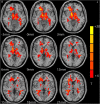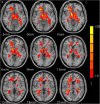Vortioxetine Modulates the Regional Signal in First-Episode Drug-Free Major Depressive Disorder at Rest
- PMID: 35845440
- PMCID: PMC9277001
- DOI: 10.3389/fpsyt.2022.950885
Vortioxetine Modulates the Regional Signal in First-Episode Drug-Free Major Depressive Disorder at Rest
Abstract
Background: Previous studies on brain functional alterations associated with antidepressants for major depressive disorder (MDD) have produced conflicting results because they involved short treatment periods and a variety of compounds.
Methods: Resting-state functional magnetic resonance imaging scans were obtained from 25 first-episode drug-free patients with MDD and 25 healthy controls. The patients, who were treated with vortioxetine for 8 weeks, were scanned at two-time points (baseline and week 8 of treatment). The amplitude of low-frequency fluctuation (ALFF) in the imaging data was used to analyze local brain signal alterations associated with antidepressant treatment.
Results: Compared with the controls, the patients at baseline showed decreased ALFF values in the right inferior temporal gyrus and increased ALFF values in the left inferior cerebellum, right cingulate gyrus and postcentral gyrus. After 8 weeks of vortioxetine treatment, patients showed increased ALFF values in the bilateral cingulate gyrus, middle temporal gyrus, medial superior frontal gyrus, and inferior cerebellum.
Conclusion: This study provided evidence that vortioxetine modulates brain signals in MDD sufferers. These findings contribute to the understanding of how antidepressants effect brain function.
Keywords: MRI; amplitude of low-frequency fluctuation; major depressive disorder; temporal lobe; vortioxetine.
Copyright © 2022 Xiong, Li, Zhou, Ren, Lin, Zhang and Xiang.
Conflict of interest statement
The authors declare that the research was conducted in the absence of any commercial or financial relationships that could be construed as a potential conflict of interest. The reviewer XJ declared a shared affiliation with the author SZ at the time of review.
Figures



Similar articles
-
Amplitude of low-frequency oscillations in first-episode, treatment-naive patients with major depressive disorder: a resting-state functional MRI study.PLoS One. 2012;7(10):e48658. doi: 10.1371/journal.pone.0048658. Epub 2012 Oct 31. PLoS One. 2012. PMID: 23119084 Free PMC article.
-
Identify abnormalities in resting-state brain function between first-episode, drug-naive major depressive disorder and remitted individuals: a 3-year retrospective study.Neuroreport. 2018 Aug 1;29(11):907-916. doi: 10.1097/WNR.0000000000001054. Neuroreport. 2018. PMID: 29912848
-
Changes in the amplitude of low-frequency fluctuations in specific frequency bands in major depressive disorder after electroconvulsive therapy.World J Psychiatry. 2022 May 19;12(5):708-721. doi: 10.5498/wjp.v12.i5.708. eCollection 2022 May 19. World J Psychiatry. 2022. PMID: 35663299 Free PMC article.
-
Common and distinct patterns of intrinsic brain activity alterations in major depression and bipolar disorder: voxel-based meta-analysis.Transl Psychiatry. 2020 Oct 19;10(1):353. doi: 10.1038/s41398-020-01036-5. Transl Psychiatry. 2020. PMID: 33077728 Free PMC article. Review.
-
Disruption of resting-state functional connectivity of right posterior insula in adolescents and young adults with major depressive disorder.J Affect Disord. 2019 Oct 1;257:23-30. doi: 10.1016/j.jad.2019.06.057. Epub 2019 Jul 2. J Affect Disord. 2019. PMID: 31299401
Cited by
-
Associations between abnormal spontaneous neural activity and clinical variables, eye movements, and event-related potential indicators in major depressive disorder.Front Neurosci. 2023 Jan 11;16:1056868. doi: 10.3389/fnins.2022.1056868. eCollection 2022. Front Neurosci. 2023. PMID: 36711124 Free PMC article.
-
Altered functional brain activity in first-episode major depressive disorder treated with electro-acupuncture: A resting-state functional magnetic resonance imaging study.Heliyon. 2024 Apr 15;10(8):e29613. doi: 10.1016/j.heliyon.2024.e29613. eCollection 2024 Apr 30. Heliyon. 2024. PMID: 38681626 Free PMC article.
-
Combined Cognitive Training and Vortioxetine Mitigates Age-Related Declines in Functional Brain Network Integrity.Am J Geriatr Psychiatry. 2023 Jun;31(6):385-397. doi: 10.1016/j.jagp.2023.01.004. Epub 2023 Jan 14. Am J Geriatr Psychiatry. 2023. PMID: 36739247 Free PMC article. Clinical Trial.
References
-
- First MB, Williams Janet BW, Spitzer RL, Gibbon M, et al. Structured Clinical Interview for DSM-IV Axis I Disorders-Patient Edition (SCID-I/P). (1997). Oxford: Oxford University Press.
-
- Xu LL, Liu GY, Zhang L, Cao L, Zhang J, Ma LY. Resting-state functional magnetic resonance imaging study in first-episode depression and subjects at high risk for depression. J Clin Psychiatry. (2018) 28:93–7.
LinkOut - more resources
Full Text Sources

